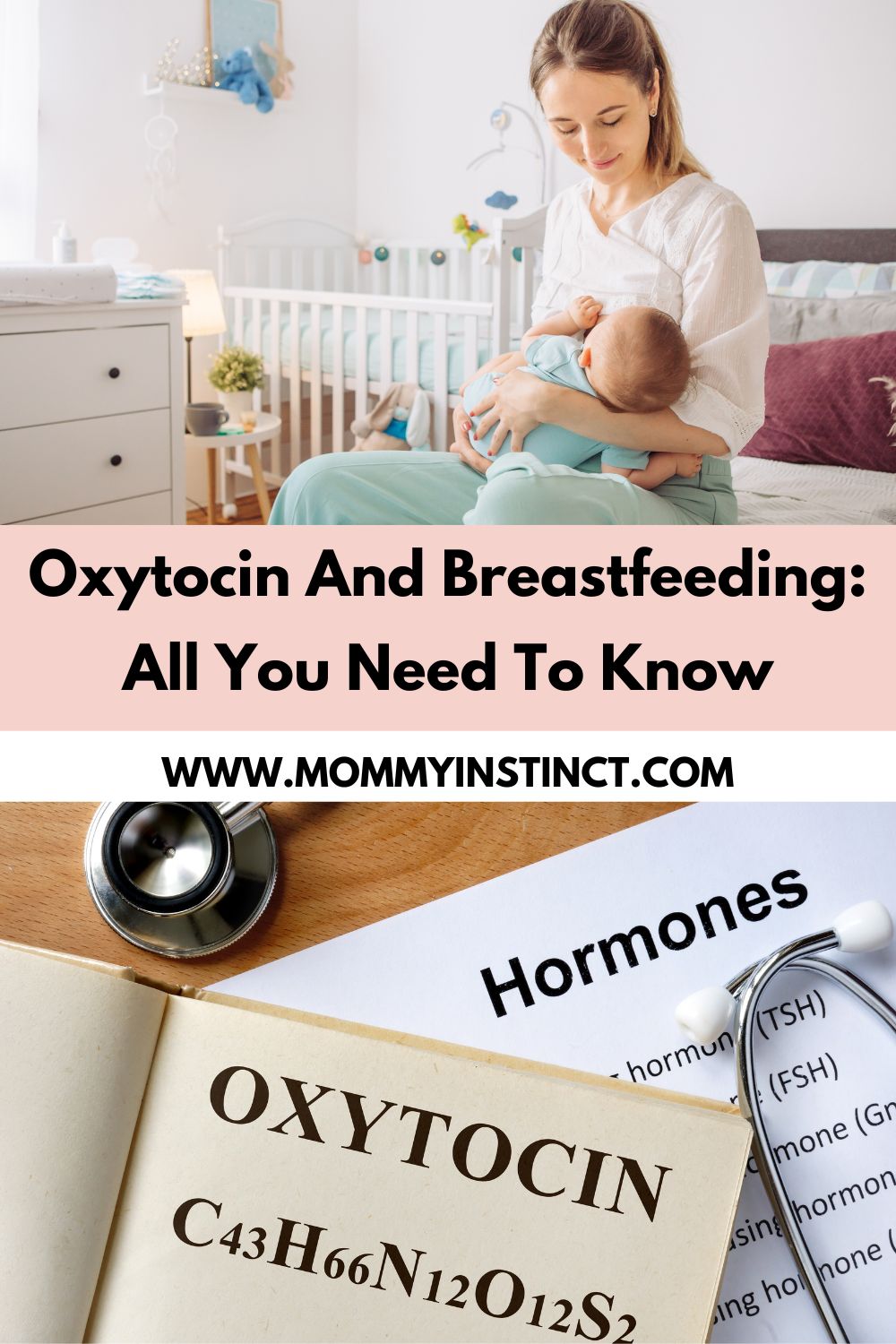Oxytocin is a hormone that affects organs in the body, including the breasts and uterus in women. Oxytocin acts as a chemical messenger in the brain that partially controls the reproductive system, especially during pregnancy, childbirth, and breastfeeding.
In addition, studies report that oxytocin is involved and influences human behavior. Not only is the love hormone, but oxytocin is also one of the two most essential hormones in milk secretion while increasing the bond between mother and baby during breastfeeding.
What is the oxytocin hormone? How to stimulate oxytocin enhances activity? We invite you to learn through our article below.
What Is Oxytocin?

Oxytocin is a hormone secreted by the pituitary gland of our human brain. It is a hormone that regulates uterine contractions, lactation, and reproductive behaviors.
For nursing mothers, oxytocin is the love hormone that also plays a bigger role in helping increase milk secretion and, simultaneously, the bond between mother and baby. The mechanism of action of oxytocin is as follows:
Sensory impulses will be transmitted from the breast to the brain when the baby suckles. Hence, the brain will trigger prolactin and oxytocin production by the pituitary gland.
Prolactin helps stimulate lactation cells to produce milk and increases milk production reflex. Meanwhile, oxytocin helps contract the muscles around the milk follicle to guide milk to the nipple, increasing the ejection reflex.
On the other hand, oxytocin is strongly secreted during breastfeeding, which also helps to strengthen the bond between mother and baby.
The Crucial Of Oxytocin In Breastfeeding
Breastfeeding causes your brain to produce more oxytocin. It allows the baby to suck milk from the breast and causes the uterus to contract after childbirth. It also promotes love, nurturing, and a strong emotional bond between you and your child.
The release of oxytocin while breastfeeding can make you feel drowsy and relaxed. It can raise your body temperature, so you can feel hot while breastfeeding. It can also make you feel thirsty or give you a headache.
Oxytocin and the let-down reflex

When your baby's breast milk and your baby's mouth touch your breast, especially your nipple, nerve cells in your chest send signals to your brain to release oxytocin.
Oxytocin causes the muscles around the milk-producing glands in your breasts to contract. When the glands contract, breast milk is pushed into the milk ducts.
Besides, the milk ducts also contract to push breast milk through your breast and out of the nipple to your baby. This release of breast milk from your breasts is called the down reflex.
More oxytocin is released as your baby continues to breastfeed, and your breast milk continues to flow out of your breasts and to your baby.
Oxytocin can also cause your milk to drop when you're not breastfeeding. When you think about breastfeeding or hear your baby cry, your breasts may begin to leak breast milk.
While oxytocin is responsible for the down reflex and the release of breast milk from your body, it has nothing to do with the amount of breast milk you will make. The hormone involved in the production of breast milk is called prolactin.
Bonding with your baby

The oxytocin release during breastfeeding can also assist you in developing a strong emotional bond with your baby. Plus, the hormone is in charge of the feelings of love that cause you to want to nurture your child.
Both mom and baby produce oxytocin during breastfeeding and skin-to-skin contact. Hence, skin-to-skin contact is frequently advised immediately after birth to aid in the release of oxytocin.
It encourages the baby to seek out and latch on to the breast, resulting in a strong attachment and increased chances of breastfeeding success.
Oxytocin to reduce pain
Oxytocin is also an effective pain reliever, particularly for chronic headaches. This hormone can relieve pain after 4 hours, but the effect lasts only 24 hours.
In addition to its role as a catalyst to help strengthen relationships in life and reduce pain, the hormone oxytocin also offers certain health benefits as follows:
Reduce stress: Cortisol is a hormone capable of causing human anxiety and stress. The "love hormone" will assist the body in significantly lowering the amount of this harmful hormone while also balancing blood pressure and increasing feelings of closeness and intimacy.
Improve memory: Oxytocin aids in the recall and retention of beautiful memories from the past, particularly memories of motherhood. These important aspects of everyone's life contribute to a happier life.
Some other health benefits: help reduce postpartum bleeding; support effective treatment of mental conditions such as autism or difficulty interacting with society; improve women's postpartum depression or alcohol abuse disorders.
Recognize When Your Body Is Releasing Oxytocin

Due to its important role in milk ejection, oxytocin is essential to the lactation process. If you have difficulty breastfeeding, you should consider how your body releases the hormone.
Signs that your body is releasing Oxytocin
How can you tell if the oxytocin in your body is working correctly? Here are some signs you can recognize easily:
Ways To Stimulate Oxytocin Release
If you have issues with oxytocin release, there are ways to stimulate hormone production and thus milk let-down to help you overcome breastfeeding difficulties. You might think about experimenting in the following ways:
Acupressure massage

Regarding Oriental medicine, a massage is also a form of helping release oxytocin. Experts point out that massage can increase and regulate the availability of neurohormones (including oxytocin) that affect the brain and the body's psychological response.
A study by Cedars Medical Center - Sinai, Los Angeles, USA, determined a decrease in the stress hormone and a significant increase in the hormone oxytocin after the trial participants were massaged for 45 minutes.
The Swedish light massage method mainly uses massaging, squeezing, and patting many muscles, suitable for people who can't stand the pain and pregnant women.
Thus, this method has been shown to increase oxytocin flow. You can reduce pain and feel more relaxed with specific breathing patterns.
Supplement the necessary foods
You can add foods rich in vitamins D, C, magnesium, and taurine. Ingredients in some herbal teas, such as jasmine tea and fenugreek... also help stimulate oxytocin secretion.
In particular, the herb known to be the most potent oxytocin stimulant is blessed thistle, a plant native to the Mediterranean.
Humans have used this herb for a long time to cure and treat lactation and lack of milk in postpartum women.
Give your baby regular breast milk

Your breast will continue to produce milk, depending on how much milk is pumped out. In other words, breastfeeding frequently triggers the production of two hormones: prolactin and oxytocin.
That is to say, regularly breastfeeding stimulates the nerves in the breast to send messages to the pituitary gland in the mother's brain. Then, the pituitary gland secretes the hormones oxytocin and prolactin.
The hormone prolactin acts on the mammary glands to make breast milk. In contrast, oxytocin signals the lactation reflex by causing the alveoli to contract and forcing breast milk into the ducts to feed the baby.
Thus, milk production will be reduced if milk is not pumped out regularly or the breasts are not fully expressed. In addition, breasts are prone to discomfort and engorgement if you delay or skip breastfeeding.
As a result, breastfeeding mothers are encouraged to breastfeed their babies as often as they show signs of hunger. Most experts recommend letting your baby empty one breast, then switching to the other.
Make eye contact with your baby
When you smile warmly and look at your little one, the hormone oxytocin in the body can be boosted to create a feeling of trust.
Cuddle with your baby
When sharing warm hugs with your newborn, the happiness hormone will be released abundantly, making you feel warm and loved.
Hold your baby’s hand
Touch, especially holding your infant’s hands, can lower the stress hormone cortisol, reduce blood pressure, and increase the release of oxytocin.
Kiss your baby
A warm kiss can trigger the release of the hormone dopamine and create a feeling of euphoria, and it can also help generate a rush of oxytocin levels.
Listen to music and dance
Music and dancing improve your mood and can stimulate the release of the hormone oxytocin.
Using nasal oxytocin spray (Pitocin)
If you are in pain, you should take the medication prescribed by your doctor. It may make your baby sleepy, but it can help you feel more at ease and get breastfeeding off to a good start.
A doctor can prescribe Pitocin, synthetic oxytocin, as a nasal spray for women who have difficulty letting down their milk. It is taken immediately before breastfeeding or pumping to help with let-downs and getting the breast milk flowing.
It can give a mother headaches but does not affect the newborn or breast milk. Hence, you can rest assured when using it.

Closing
On the whole, oxytocin is the substance that stimulates the smooth muscle cells of the milk follicles in the breast to increase activity. It helps in better milk flow.
The milk comes out well; the longer the baby sucks, the more breast milk is produced, thus minimizing the lack of milk and early milk loss. Therefore, oxytocin and breastfeeding are closely related.

